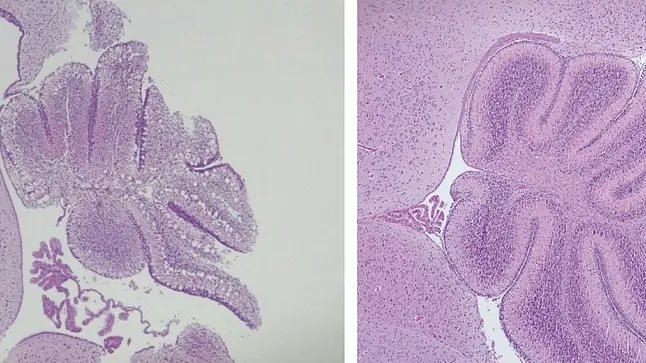The cause of his progressive paralysis was a rare mitochondrial disease, an encephalopathy due to mutations in HPDL that caused a deficiency of coenzyme Q10; a disorder that the family was familiar with because it had already caused the death of his two younger siblings.
Everything seemed to indicate that the disease would be equally lethal for J., but an experimental therapy has changed his prognosis. Today, the child has regained much of his mobility and, although he still faces difficulties, he can walk and even run. The details of his treatment are published in the latest issue of the scientific journal Nature.
Spanish Begoña Gamallo Lana is one of the members of the team at New York's Langone Hospital (NYU Langone) who administered this innovative therapy to the child.
"Coenzyme Q10 is a natural antioxidant found in all cells of the body and plays a key role in helping cells generate energy and protect them from oxidative damage," explains Gamallo Lana via email.
By administering precursor molecules of coenzyme Q10 - the so-called 4-HMA and 4-HB - scientists managed to improve neurological function in genetically modified mice to emulate the disease as well as in J., who due to mutations in HPDL had a deficiency of coenzyme Q10.
In the child, "this precursor treatment showed a significantly greater clinical benefit than the current standard treatment, which consists of direct supplementation with CoQ10," notes Gamallo Lana.
The experimental treatment, continues the Spanish researcher, was made possible by a rapid translation of the results obtained in the laboratory to the clinic.
"CoQ10 has two parts, a 'tail' and a 'head'. The tail keeps CoQ10 in the right place inside the cell, while the head is responsible for accepting and donating electrons. For some years, it has been known how the 'tail' is formed, but it was not until four years ago that Professor Michael Pacold and his team discovered how the 'head' of this coenzyme is formed in the human body. They identified that a protein called HPDL produces an important precursor molecule, 4-hydroxymandelate (4-HMA), which then converts into 4-hydroxybenzoate (4-HB), and the latter can lead to the production of CoQ10," she points out.
With this information, the team conducted experiments on genetically modified mice to eliminate the HPDL gene from their genome, which caused disability. However, the researchers found that if they added the precursors 4-HMA or 4-HB to the water they drank, over 90% recovered much of their normality and lived into adulthood, instead of becoming progressively paralyzed and dying.
A race against time investigation
It was J.'s family who turned to the research group due to the rapid deterioration the child was experiencing. "We had to act under pressure, as the child's symptoms were worsening, but we received support from many people. We prepared the application for the use of investigational drug for a single patient during the Thanksgiving holiday and sent it to the U.S. Food and Drug Administration, FDA, shortly after. The FDA approved it very quickly, and the NYU institutional ethics committee also acted swiftly and approved the treatment shortly after," notes the team that Gamallo is part of, based in the U.S. since 2016 and whose main line of research focuses on understanding the neural and pharmacological bases of short-term memory, as well as complex decision-making. She also works in the Rodent Behavior Laboratory at NYU Langone.
The oral treatment with 4-HB - diluted in water - began in December 2023, and two months later, the child was already showing improvements in his motor skills. After 250 days of treatment, the child was able to run and take lateral steps to pick up a ball. Additionally, he went from falling several times a day to rarely experiencing that. However, the recovery was not complete, and he still has spasticity issues.
Today, "the patient continues to receive the treatment and continues to improve," says the researcher, emphasizing that "generally, scientific advances take a long time to become treatments for patients. In this case, we feel especially grateful to have been able to apply a fundamental discovery and offer treatment to a patient in such a short time."
As highlighted by the researchers in the scientific journal, this work is the first demonstration that the symptoms of a primary CoQ10 deficiency can be stabilized or improved by supplying not the complete coenzyme, but its precursors.
The issue with administering the complete coenzyme is that, even with large doses, only a small part reaches its destination due to its structure, they point out. This would explain why the treatment based on the molecule has not been able to reverse the neurological symptoms of this type of mitochondrial diseases, they add.
Nevertheless, Gamallo Lana recalls that to determine if this experimental treatment can be useful against this disease, "it will be necessary to start a clinical trial" with other children with encephalopathy due to mutations in the HPDL gene.
According to Marcello Bellusci, a neuropediatrician and specialist in mitochondrial diseases at the 12 de Octubre Hospital in Madrid, fulfilling that step will be challenging, as it is an ultra-rare disease. "There are very few cases of mutations in this gene worldwide," he explains.
"Since there will be few patients to conduct a trial, it will be complicated to demonstrate in a scientifically robust way that this new treatment they have discovered will work better than direct administration of CoQ10," he explains.
"Longer-term follow-up would be needed, treating patients early, and having a sufficient volume of patients to see if it can determine a significant change in treatment," he concludes.
